Other Races
A reminder that it's expected that your character should reasonably represent the nature, alignment, and appearance of any race according to their lore. One step from their lore alignment is typically allowed.
Goblin
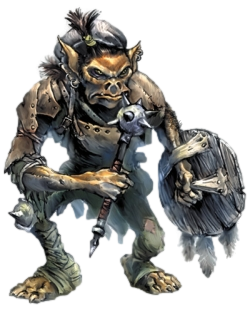
A goblin stands 3 to 3½ feet tall and weigh 40 to 45 pounds. Its eyes are usually dull and glazed, varying in color from red to yellow. A goblin’s skin color ranges from yellow through any shade of orange to a deep red; usually all members of a single tribe are about the same color. Goblins wear clothing of dark leather, tending toward drab, soiled-looking colors. Goblins speak Goblin; those with Intelligence scores of 12 or higher also speak Common.
Goblin Racial Traits
- -2 Strength, +2 Dexterity
- Small size: +1 bonus to Armor Class, +1 bonus on attack rolls, +4 bonus on Hide checks, -4 penalty on grapple checks, lifting and carrying limits ¾ those of Medium characters.
- Darkvision out to 60 feet.
- +4 racial bonus on Move Silently and Ride checks.
- Automatic Languages: Common, Goblin.
- Favored Class: Rogue.
Hobgoblin
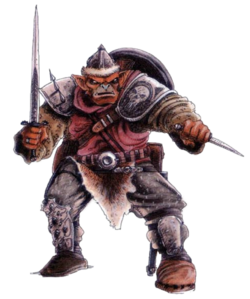
Hobgoblins are larger cousins of goblins. Hobgoblins’ hair color ranges from dark reddish-brown to dark gray. They have dark orange or red-orange skin. Large males have blue or red noses. Hobgoblins’ eyes are yellowish or dark brown, while their teeth are yellow.
Their garments tend to be brightly colored, often blood red with black-tinted leather. Their weaponry is kept polished and in good repair. Hobgoblins speak Goblin and Common. Most hobgoblins encountered outside their homes are warriors; the information in the statistics block is for one of 1st level.
Hobgoblin Racial Traits
- +2 Dexterity, +2 Constitution.
- Darkvision out to 60 feet.
- +4 racial bonus on Move Silently checks.
- Automatic Languages: Common, Goblin.
- Favored Class: Fighter.
- Level adjustment +1.
Maenad
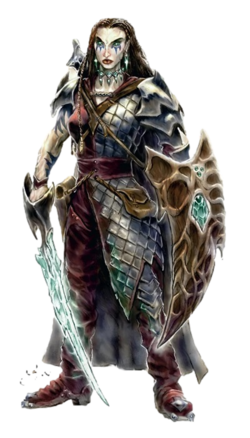
Maenads are a race rumored to be wildly emotional, but perceived as extremely reserved by those who encounter them. In fact, both rumor and perception are true: Maenads have developed strict self-control as a means of holding their intense emotional turmoil at bay. On the rare occasion when a maenad loses his control, a flood of emotion rises to the surface, often to be released in acts of stunning bravery or violence. Maenads have a strong martial bent, useful for venting the passions they keep bottled up. Maenads know not the source of their spiritual anger, but legend has it that they were terribly wronged by a higher power in some distant time. Some tales suggest that the maenads were a race of bestial creatures who were able to contain their mad frenzy only after overthrowing their own deity.
Personality: Maenads seem discreet and calm, restrained and undemonstrative, unwilling to use a sentence when a word will do, and happier still with a gesture if words can be dispensed with altogether. To maintain a life in civilized lands and even (or especially) among themselves, maenads must practice a discipline of mental calm, lest the fury of their racial memories break forth.
Physical Description: Maenads are tall and wiry, standing over 6 feet tall and typically weighing around 200 pounds, with maenad males the same height as and only marginally heavier than maenad females. They wear the dark hair on their heads long and braided (and have no hair elsewhere on their bodies). Their skin is dusted with a peculiar sparkle, as of gem dust, giving them a striking luster in the right light. This sparkle is a natural component of their skin, which is flecked with bits of living crystal. Maenads possess grace and fine features, and are almost elven in their beauty. They prefer heavier clothing, and wear armor if it's available.
Relations: Maenads are most comfortable with humans, finding that race's various temperaments not too dissimilar to their own. They respect the dwarves' ability to hold a grudge. Maenads are particularly taken with elves; the elves' lightness of being is a balm to the maenad spirit. Maenads don't dislike halflings, gnomes, or xephs, but have a hard time understanding their capricious ways.
Alignment: Maenads know that self-control is their best path to a fulfilling life. Thus, they lean strongly toward law. Generally, they value and protect others' self-control as well as their own, and so are good-aligned more often than not.
Maenad Lands: For the most part, maenads live in coastal communities with populations less than three hundred. Their well-hidden villages blend into the cliffs and surf. They hunt some game inland but gather most of their nourishment out at sea in light, cunningly built boats. Some maenads use their boats for commerce up and down the coast, trading pearls and grown crystal sculptures. Maenads encountered in human lands are usually warriors for hire or adventurers.
Religion: Maenads worship various minor deities of the sea. Obad-Hai, as he relates to the seas and oceans, is also a deity known to the maenads.
Language: Maenads speak a language governed by strict rules of grammar. Chants play an important part in their songmaking and literature. They use the Elven alphabet for their script.
Names: Maenad names are given and used much like human names. Every maenad has at least one given name and a family name.
Male Names: Alberik, Alrik, Basilius, Erland, Gunnar, Isak, Ragnor, Rurik, Tor.
Female Names: Agaton, Annalina, Blenda, Eleonora, Gala, Lena, Malin, Ragnara, Vedis.
Family Names: Coebelliantus, Hjalmar, Kolbjorn, Perchnosius, Torborn, Valborg, Valentin, Xaljorn.
Adventurers: Some maenads take up adventuring out of a desire to travel and see the world. Others become adventurers because they tend to get along easier with those less given to inner rage than with others like themselves.
Meanad Racial Traits
- +2 Wisdom
- Medium size.
- Automatic Languages: Common.
Orc
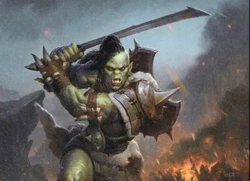
An orc’s hair usually is black. It has lupine ears and reddish eyes. Orcs prefer wearing vivid colors that many humans would consider unpleasant, such as blood red, mustard yellow, yellow-green, and deep purple. Their equipment is dirty and unkempt. An adult male orc is a little over 6 feet tall and weighs about 210 pounds.
Females are slightly smaller.
The language an orc speaks varies slightly from tribe to tribe, but any orc is understandable by someone else who speaks Orc. Some orcs know Goblin or Giant as well.
Orc Racial Traits
- +2 Strength, -2 Charisma.
- Darkvision out to 60 feet.
- Automatic Languages: Common, Orc.
- Favored Class: Barbarian.
Sea Elves
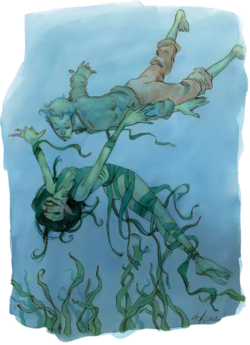
Two races of elves make their homes in the depths of the ocean: the Dargonesti (Deep Elves, or Quoowahb [KWOO-wab] in their native tongue) and the Dimernesti (Shoal Elves). The following traits are shared by both races, which are described in greater detail afterward.
Personality: Proud and hot-blooded, sea elves are passionate in everything they do, a trait not commonly associated with the long-lived elves.
The Dargonesti are reserved around other races, and elves mistakenly consider them uncivilized. Among themselves, Dargonesti work to achieve harmony with their environment and enjoy life to the fullest.
The fiercely independent Dimernesti reflect the same qualities possessed by the Kagonesti. After centuries of loss inflicted upon them by the Cataclysm, the sea dragon Brynseldimer, and other terrors, Dimernesti are sullen and have abandoned their faith and trust in outsiders. They display an aloof coolness when forced to deal with others.
Physical Description: Of the elven races, the two varieties of sea elves are the tallest. Dargonesti men approach 7 feet in height, and women average 6 feet. Dimernesti males average around 6 1/2 feet while women average 6 feet in height. Though burly in comparison to other elves, an average sea elf is sleek and slender when compared to a human, with wiry and agile frames. Dargonesti skin is the deep blue of the ocean, which enables them to blend in well with the ocean waves, while Dimernesti have light blue skin. The fingers and toes of both races are long and webbed, allowing them to glide easily through the water, and they have small, feathery gill slits just below each of their pointed ears. Dargonesti hair color ranges from pale gold to dark green, with a rare few having silver or black, while Dimernesti have silver hair that they wear long, often braided with coral and shells. Dargonesti eyes are large for their face, with narrow pupils; the colors ranging from palest blue-green to deep indigo with the occasional yellow or black. Sea elves achieve adulthood around the age of 40 years. The Dargonesti can live to be almost a thousand years old, while a typical Dimernesti reaches only half that age.
In the water, sea elves wear little clothing. They may drape themselves with seaweed or weave clothing from plants. Sea elves who visit the surface may disguise their distinctive blue skin in cloaks and robes.
Relations: The Dargonesti are isolationists, even more so than the Silvanesti. Though they do interact with the various other aquatic races, such as the merfolk and tritons, the proud Dargonesti keep to themselves. They hold a disdainful view of their Dimernesti cousins, considering them children who are afraid to swim in deep water.
They consider the Silvanesti and Qualinesti to be arrogant and ignorant, stagnant and corrupt. For their part, the Silvanesti are still bitter toward both the Dimernesti and Dargonesti for their "betrayal" - abandoning the land for life in the sea. The Dargonesti are more friendly toward the Kagonesti, with whom they share similar beliefs.
Other races, such as humans, dwarves, gnomes, and kender, are a curiosity to the Deep Elves. Occasionally, a contingent of Dargonesti will save drowning sailors, bringing them to the underwater citadels where they can be observed and cared for. Typically, the Dargonesti free those of good alignment, while keeping evil-doers imprisoned. The Dargonesti hate minotaurs and draconians and refuse to rescue them, simply allowing them to drown. Minotaur sailors hate and fear the Dargonesti more than sharks.
Before the Cataclysm, the Dimernesti enjoyed a close relationship with their surface cousins, particularly with the Silvanesti. After the devastation wrought upon the Dimernesti during the Cataclysm, they splintered into small family groups, and severed ties with the surface world. During the War of the Lance, they reestablished ties with the Dargonesti to face the underwater threat of the Dark Queen, only to have those ties broken with the coming of the dragon overlords. During the Fifth Age, they have once more retreated into their isolated, underwater world, believing themselves abandoned by their kin and left to the mercies of the sea dragon, Brynseldimer.
Alignment: Freedom of choice and freedom of expression are fundamental beliefs of the sea elves, who tend toward the peaceful side of chaotic. Among the Dargonesti, lawfully inclined sea elves are not uncommon. Sea elves are aligned with good, since those who follow evil are either banished or go into voluntary exile.
Sea Elf Lands: Watermere is the ancient capital of the Dargonesti, located in a vast undersea valley northeast of Ansalon in the Courrain Ocean. The largest of the Dargonesti kingdoms, Watermere is ruled by the Speaker of the Moon, advised by a council composed of the clan patriarchs and matriarchs known as the Speakers of the Blood. Watermere is more than two thousand years old. The Dargonesti wrested it from the koalinths and have tenaciously defended it ever since. The kingdom remained relatively untouched through the Cataclysm, the War of the Lance, and the Chaos War, but during the War of Souls, much of the kingdom was lost.
The Dargonesti have established a number of smaller, fortified citadels in trenches in the ocean, which serve as ancestral keeps for the various Dargonesti clans, allowing them to protect the borders of their kingdom. In recent times, many of these citadels have fallen and now lie in ruins. When the city of Istar was destroyed during the Cataclysm, it sank to the floor of the Blood Sea. The ruins became a home for the Dargonesti, who live within the city they believe to be a gift to them from the gods.
In current times, the only city of the Dimernesti is the underwater city of Dimernost. Before the Cataclysm, the Dimernesti were a thriving society with small cities scattered around the coastline of Ansalon. The quakes caused by the Cataclysm affected the land beneath the waves, creating new seas and altering coastlines. Many Dimernesti were killed, and they lost most of their cities. After that time, they no longer built cities, but lived in small family groups that move constantly from place to place, making their homes in kelp beds, coral reefs, and in shipwrecks beneath the water. Occasionally, Dimernesti raiding parties sneak ashore to raid nearby settlements for tools and other necessities.
Traditionally, the Dimernesti are ruled by Speaker of the Sea, a hereditary, matriarchal ruler who lives in the Tower of the Sea in Dimernost. With the arrival of the dragon Brynseldimer during the dragon purge, communication between the Speaker and outlying families has been severed.
Religion: The sea elves are a deeply religious people, having maintained their faith in the deities even during those times the gods were absent. Traditionally, the sea elves worship Abbuku the Fisher (Habbakuk) and Kisla the Mother of Sea Creatures (Chislev) as their primary gods, though all temples also hold a shrine to Zura the Maelstrom (Zeboim), to placate the dark and volatile goddess of the sea. The sea elves also worship Estarin (Branchala), Ke-en (Mishakal), Krijol (Kiri-Jolith), and Matheri (Majere). The Dargonesti pay homage to all three deities of magic, for they recognize that the moons hold sway over the tides of the ocean.
Language: Though based upon archaic Elven, the Dargonesti language has changed over the millennia since they separated from the Silvanesti. It uses the Silvanesti alphabet, but has harsher consonants and softer, extended vowels.
In the water, the language adopts a chattering patter, similar to the clicking of dolphins. From rescued sailors, the Dargonesti have been exposed to a wide variety of languages, though they rarely consider it necessary to learn them.
Unlike the Dargonesti language, the Dimernesti language maintains a much closer tie to the Silvanesti tongue, though it possesses characteristics that make it closer to a regional dialect. Since they have much greater interaction with the surface dwellers than the Dargonesti, the Dimernesti have picked up other languages, particularly those of the Ergothians and the minotaurs, who both ply the waterways.
Names: Dargonesti names reflect their environment, though many are derivatives of ancient elven names. Family names are as important as first names, because they denote clan affiliation. Though they may live far apart, those families bearing the same name are still members of the same clan. Since Dimernesti are raised in a communal environment, family names do not play a role in their society. Names often reflect the Dimernesti's love of water and the plants and animals that live in the sea.
Dargonesti Male Names: Broron, Coryphene, Drudarch, Imbrias, Kios, Nakaro, Naxos, Ponthax, Treyen, Urion.
Dargonesti Female Names: Apollata, Areme, Belana, Drian, Kolys, Myre, Queelas, Sharlao, Telarian, Zelara.
Dargonesti Clan Names Bluedancer, Crystalcutter, Dargonis, Deepstar, Grayspear, Moonshell, Seashimmer, Silverwake, Takulrion, Whitebreaker.
Dimernesti Male Names: Breegan, Dalmeen, Elan, Jolnen, Kridal, Malkwen, Oolen, Qwendeel, Ulanan, Zelnath.
Dimernesti Female Names: Alaqana, Brea, Demorna, Kira, Nuqala, Preena, Queela, Seera, Ulana, Veylona.
Adventurers: Sea elves do not travel alone, for the vast ocean holds countless dangers. Sea elves hear tales of the surface world from rescued sailors and some are lead by curiosity to disguise themselves and travel to the surface. Surface-walking sea elves tend to be loners and outsiders, never fully comfortable with life away from their beloved ocean.
Dargonesti Racial Traits
- +2 Strength, +2 Dexterity, -2 Charisma.
- Automatic Languages: Common and Elven.
- Favored Class: Fighter.
- Level Adjustment +1.
Dimernesti Racial Traits
- +2 Dexterity, +2 Intelligence, -2 Wisdom, -2 Charisma.
- Automatic Languages: Common and Elven.
- Favored Class: Barbarian.
- Level Adjustment +1.
Xeph
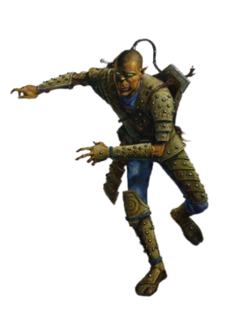
Xephs are acknowledged for their skill in feats of agility, their uncontested ability at generating bursts of speed, their matchless knowledge of movement and distance, and their capacity for humor. Xephs are celebrated for the fabulous objects of subtle beauty they produce for trade. Their lands lie far to the east, contained within a great rift that hides a broad valley permanently plunged into darkness, except for several psionically illuminated forests. Despite the lack of sunlight in this environment, xephs thrive.
Personality: Xephs are quick to laugh or joke, welcoming of strangers, and especially charitable to those who really earn their confidence. If they are betrayed by a friend, xephs are dwarflike in their resolve to seek justice and redress. Xephs value artful sculpture, beautiful paintings, expensive clothing, and other art objects. They prefer to avoid a fight rather than wade in, but they are not timid if combat is their only recourse.
Physical Description: Xephs stand about 5-1/2 feet tall and are slender and graceful, usually weighing about 140 pounds. Males are typically taller and heavier than females. Xephs' skin is typically brown, and their eyes are dark. Their hair is usually black and straight; some wear it clipped short, while others shave their heads except for a topknot and weave that hair into a single long braid.
Relations: Xephs get along well with humans, half-elves, and halflings. They think that elves might be a little too good to be true, while they view half-orcs and half-giants with some suspicion. Xephs and maenads tend to rub each other the wrong way; xephs see maenads as too stiff (little realizing the reason why), while maenads envy xephs their free and easy attitude.
Alignment: Xephs tend toward good. Those who take up the soulknife class learn to be lawful, though on balance, the race is somewhat chaotic.
Xeph Lands: Xeph cities are found far to the east across wide-open savannas, then deep below the lip of a great rift, where darkness reigns. There they practice their arts and sing their songs under the boughs of a gloriously illuminated forest. Members of other races are welcome in the forest, though some ancient temples are off limits to those not of the blood. The wealth the xephs own is due in part to their artistic bent, and in part to their desire to travel far and wide to trade for the wealth and art of other cultures. Some prefer overland caravans, others seagoing ships.
Religion: The chief deity of the xephs is Fharlanghn, the Dweller on the Horizon. He is the deity of travel, roads, distance, and horizons, all of which are concepts that stir the xeph soul.
Language: Xephs speak their own language, which uses the same alphabet as Common. Some also learn Sylvan, the language of fellow wanderers.
Names: A xeph's name is granted to her by her parents on her fourth birthday. Most xeph names are used and reused down through the generations. Xephs who travel usually take the name of their city of birth as a second name, a reminder of where they originally began their journey through life.
Male Names: Assim, Bahram, Behrooze, Cyrus, Jamsheed, Ksathra, Majeed, Mehrdad, Nasim, Shatrevar, Xerxes.
Female Names: Amira, Azar, Cyra, Darya, Jaleh, Marjan, Narda, Shahin, Soraya, Zenda.
Second (City) Names: Asha, Dareh, Feroz, Kurush, Melchior, Saeed, Val.
Adventurers: A xeph adventurer is usually motivated merely by the thought of travel and exploration itself. A xeph may also be motivated by the desire to see new wonders, feats of might, psionics, or magic great enough to inspire the xeph to greater works of personal art.
Xeph Racial Traits
- +2 Dexterity, -2 Strength.
- Medium size.
- Darkvision out to 60 feet.
- +1 racial bonus on saving throws against powers, spells, and spell-like effects. Xephs have an innate resistance to psionics and magic.
- Automatic Languages: Common.
Kenku
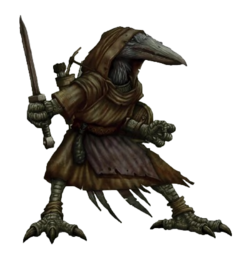
Kenkus evolved from avians, although they no longer possess wings or the ability to fly. Soft, dark feathers cover a kenku's head and torso, although its scrawny arms and legs remain bare.
Selfish and secretive in their dealings, kenkus gather in large cities, lurk in dark alleys, and hoard purloined gold. They rarely travel alone, instead preferring to roam the streets in small gangs, all the while hatching plots to amass more wealth and power. Due to their penchant for shady ventures, they are often employed as thugs, thieves, spies, and assassins.
Beneath their unremarkable brown robes, kenkus conceal a variety of useful tools and weapons. Vicious but cowardly, kenkus usually flee or surrender the instant things start to go badly for them.
Kenkus hatch like birds and dwell in family aeries and nests, most of which are located in or near large cities. At age nine, a young adult kenku leaves the home-nest forever and strikes out on its own, usually falling in with small groups of like-minded kenkus. Adult kenkus remain with these groups for mutual protection and gain. A few strike out on their own or partner with other types of creatures who value the services a kenku can provide.
Kenku characters tend toward neutrality; although most kenkus are evil, neutral and neutral good kenkus also exist. Kenkus favor the rogue class and often pursue the assassin prestige class. Kenku clerics are rare, but those that exist typically worship Vecna, the god of secrets.
A kenku averages 5 feet in height. Because its bones are partly hollow, it weighs a mere 75 pounds.
Kenku Racial Traits
- +2 Dexterity, -2 Strength.
- Medium size.
- Low-light vision.
- Mimicry (Ex): A kenku can perfectly mimic familiar sounds, voices, and accents. This ability does not enable the kenku to speak languages it can't normally speak. To duplicate a specific individual's voice, a kenku makes a Bluff check; a listener familiar with the voice being imitated must succeed on an opposed Sense Motive check to discern that the voice isn't genuine.
- +2 racial bonus on Hide checks and Move Silently checks.
- Automatic Languages: Common and Animal.
- Favored Class: Rogue.
Dromite
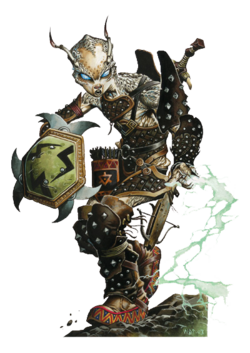
Dromites might be mistaken for halflings at a distance, due to their diminutive stature. However, closer scrutiny reveals dromites to have hardened, chitin-encrusted skin, compound eyes like those of an insect, and two small antennae protruding from their brows. Called "bug-men" by the ignorant, dromites share far more traits with humans than they do with insects. One major difference between dromites and most other races is their androgynous physiology. Aside from their Grand Queen (female) and their Elected Consort (male), dromites are genderless and possess no sexual characteristics.
Personality: Dromites vary in their temperament, but each usually exhibits one of four personality types, depending on the caste that dromite eventually joins. Those of the Fire Caste are often quick to anger, but also quick to laugh and forgive. Those of the Ice Caste are analytical, slow to make decisions, but often right. Those of the Voice Caste are consummate artists, reveling in all types of performance, especially song. Those of the Glimmer Caste always move at high speed, rarely resting in their pursuit of life's tasks. Each caste identifies with the energy type associated with its creed: fire, cold, sonic, and electricity, respectively. The four major castes are important to dromites, but are not the race's only form of social organization. Despite being a sexless society, dromites form close emotional bonds with others of their race, especially within the confines of self-selected groups known as life bonds. These relationships are similar to what other races refer to as marriages, but a life bond usually contains more than two members. As older members of a life bond die, new members are brought in, so a life bond persists long after the original members are no longer a part of it. A single life bond may contain members of several castes.
Physical Description: Dromites stand about 3 feet tall. They are essentially humanoid in appearance, if a bit thin. Their chitinous skin provides dromites with some protection against injury. Dromites have no body hair; where a humanoid might possess a head of hair, a dromite has a thin coating of convoluted chitin that smoothly rises from its skin and extends down the back of its head, neck, and the rest of its body. Dromites are not fully covered in chitin, but it is noticeable on their shoulders, torsos, the backs of their hands, and other vulnerable spots (including their heads). A dromite's eyes are striking - sparkling, almost luminescent orbs, subdivided into hundreds of tiny cells. Two small antennae sprout from its head; they move in accordance with the creature's actions or moods. They wear heavy boots and light clothing, sometimes nothing more than a sturdy harness for holding and carrying gear.
Relations: Dromites are accepting of other races, though other races sometimes find them a bit too exotic (giving rise to the derogatory term "bug-man"). Half-orcs and humans seem the most prone to using the name, apparently acting out of some inner fear of or prejudice against insects - despite the dromites' nearly humanoid appearance.
Alignment: Dromites tend toward no particular alignment, not even neutral. The best and the worst are found among them.
Dromite Lands: Dromite city-hives can be found under any land, but are usually secret and have only a few openings to the surface or to some other subterranean location. Since dromites are naturally psionic and adherents of the psionic arts (especially psychokinesis), some city-hives have no physical outlets to the surface or surrounding subterranean tunnels - dromites use permanent psionic portals and psionic powers to get into and out of these most secure city-hives. Despite the location of their hidden cities, dromites have no particular desire to remain underground, and in fact seem driven to spend at least some time on the surface. Thus, some dromites may be found living temporarily or permanently in a humanoid community - if it is one that accepts a variety of races.
Each dromite city-hive contains at least one Grand Queen with female characteristics, and one Elected Consort with male characteristics. Both queen and consort are elected on a yearly basis from a pool of the most prominent city-hive residents. After participating in a special communal ceremony, they take on titular leadership roles and assume their gender characteristics. Their most important responsibility is to provide a year's worth of dromite eggs, which hatch in well-guarded nurseries located in the city-hive's core. From the eggs come dromite infants, which look more or less like most humanoid infants (except that they have antennae).
Religion: Dromites hold their Grand Queen and Elected Consort in highest regard, almost as if deities. Because the Grand Queen and Elected Consort are almost completely occupied by their responsibility to keep the race populous, they rarely make pronouncements as a true leader would - but when they do have something to say about a topic, everyone listens.
Language: Dromites speak Common. Some learn Terran, which allows them to better communicate with other creatures of the subterranean world.
Names: Dromites, when born, are chosen from the nurseries by adult dromites who have entered life bonds. The adopted dromite is named by its new "parents" according to the traditions of the life bond. Thus, dromites have a first name and a life bond family name.
First Names: Demisse, Elimu, Fela, Gebre, Idi, Idrissa, Kato, Matunda, Obi, Sefu, Vita, Xolu.
Life Bond Family Names: Adanech, Dedanech, Fanech, Gyalech, Marimech, Massawech, Nikech, Ulech.
Adventurers: Dromites who are curious about life beyond the city-hive have little trouble securing permission to venture forth and seek their fortunes. Unless a city-hive is actively expanding its borders, an excess of population leads to cramped quarters. Thus, even the less than willing are sometimes pushed out into the world, on a mission not of their choosing.
Dromite Racial Traits
- +2 Intelligence, -2 Strength
- Monstrous Humanoid: Dromites are not subject to spells or effects that affect humanoids only, such as charm person or dominate person.
- Small size.
- Chitin: A dromite’s skin is hardened, almost like an exoskeleton, and grants the character a +3 natural armor bonus to AC and one of the following kinds of resistance to energy: cold 5, electricity 5, fire 5, or sonic 5. The player chooses what type of energy resistance is gained when the character is created. (This choice also dictates which caste the dromite belongs to.) This natural energy resistance stacks with any future energy resistance gained through other effects.
- Scent: Its antennae give a dromite the scent ability. A dromite can detect opponents by scent within 30 feet. If the opponent is upwind, the range increases to 60 feet; if downwind, it drops to 15 feet. Strong scents, such as smoke or rotting garbage, can be detected at twice the ranges noted above. Overpowering scents, such as skunk musk or troglodyte stench, can be detected at triple normal range. When a dromite detects a scent, the exact location of the source is not revealed - only its presence somewhere within range. The dromite can take a move action to note the direction of the scent. Whenever the dromite comes within 5 feet of the source, the dromite pinpoints the source’s location.
- Blind-Fight: Its antennae also give a dromite Blind-Fight as a bonus feat.
- Compound Eyes: This feature of its anatomy gives a dromite a +2 racial bonus on Spot checks.
- Automatic Languages: Common.
- Level Adjustment: +1.
Bariaur
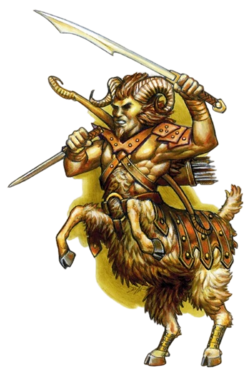
The creature looks a bit like a centaur, but it mixes the forms of human and ram rather than a human and horse. From the waist down, it is indistinguishable from a powerful ram. From the waist up, it looks human, except for two curling horns emerging from the top of its forehead.
Native to the rolling hills and woods of Ysgard, the centaurlike bariaurs wander the lands in search of evil. When a vile foe is located, the bariaurs charge into glorious battle.
Personality: To those unfamiliar with them, bariaurs appear carefree or even irresponsible, but this behavior is merely the outward sign of their wanderlust. They rarely remain in one place for long, preferring a life of travel to sedentary existence. When evil rears its ugly head, this carefree demeanor disappears, replaced by single-minded pursuit of that which endangers good folk of the area.
Physical Description: Standing roughly half a foot taller than a human, a bariaur resembles a centaur. Its lower body is that of a ram, with sleek brown or golden fur and cloven hooves. Its upper body is humanlike, powerfully muscled and sporting a pair of ramlike horns atop its head. The skin of a bariaur ranges in color from pale tan to deep nut-brown. The typical male weighs nearly 300 pounds, with females about 40 pounds lighter. The average bariaur reaches adulthood at about the same age as a half-elf, and the eldest members of the race live to well over 200 years of age.
Relations: Bariaurs are social and outgoing, though not foolishly trusting. They get along well with elves, gnomes, half lings, and wil dren, as well as aasimars who aren't too strict in their outlook. They grudgingly accept dwarves as allies against evil. Halfbreeds, such as half-elves and half-orcs, are objects of curiosity to bariaurs. They are moderately suspicious of races with heritages tied to planes of evil or shadow, including tieflings, but they prefer to take a positive outlook about individuals until proven wrong.
Bariaur Racial Traits
- +2 Strength, +2 Constitution, -2 Dexterity
- Large Creature
- Automatic Languages: Common and Bariaur.
- +1 LA
- Alignment Lock: Chaotic Good, Neutral Good, Chaotic Neutral only
Neraphim
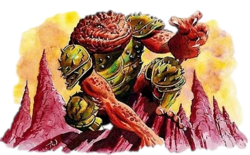
A neraph (plural neraphim) is sometimes mistaken for a slaad at a distance, due to the two races' similarity in appearance. However, neraphim and slaadi are distinct kinds of creatures, at least so far as any race can be considered distinct in the roiling chaos of the plane of Limbo.
Neraphim are a nomadic people who hunt through the maelstrom of Limbo, tracking their elusive and evermoving prey. Neraphim have developed special hunting tools and techniques, giving them exceptional skill in bringing down the game they seek above all else: the chaos beast, one of which provides a neraph tribe with a week's worth of nutrition and raw materials for clothing. They are proficient leapers, able to jump from mote to mote of stable earth in the otherwise ever-changing environment of Limbo.
For social and economic purposes, the neraphim organize themselves in houses. Each house lays claim to certain hunting grounds, giving its members access to resources within that territory. The various houses congregate once every seven years to conduct a great racial celebration known as the Festival of Spawning. During the festival, the houses negotiate with one another, exchanging resources and influence as each house seeks to better its position within the neraphim hierarchy.
Personality: Neraphim cannot afford to be as inconsistent as the plane they inhabit and the game they hunt - only stern discipline within each neraph house keeps its members from succumbing to poverty and starvation. Each house consists of a bonded group of neraphim made up of several related families and one matriarch. In the time between their Festivals of Spawning, the various neraphim houses meet only rarely, and then often in conflict over disputed hunting grounds. Alliances between houses are not uncommon, if a particular threat warrants.
Within each house, the rule of the matriarch is law, and her rule can be harsh. The most severe punishment a matriarch can dispense is exile from the house. Exiled neraphim can be encountered, though most are slain by other houses, slaadi, githzerai hunting parties, and roaming chaos beats. Some exiles have open personalities and strike up friendships with travelers from other planes, hoping to accompany them home and leave the dangerous realm of Limbo behind.
Physical Description: Neraphim are roughly humanoid in shape, with coarse red hide. Though bipedal like other humanoids, a neraph has a massive, toadlike head shaped like that of a red slaad. The range in height and weight found among neraphim is the same as found among humans. Chitinlike encrustations on a neraph's skin provides it some natural protection; however, neraphim also prefer to wear colorful bone-spiked leather (made of stabilized and cured chaos beast hide). Neraphim take longer to mature than humans do, not reaching adulthood until age 40, but they can live to be more than 400 years old.
Neraphim Racial Traits
- Neraphim gain 36 points for the stat point buy system, an increase in 6 over all other races.
- They also gain 6 times skill points at level 1, an increase from the 4 times skill points that all other races gain.
- Automatic Languages: Common.
- +1 LA
- Alignment Lock: Neramphim may only be of chaotic alignment.
Rogue Modron
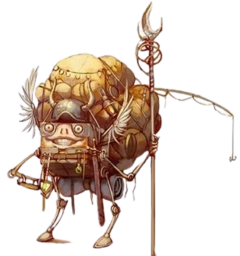
Modrons are a race of immortals known for their zealous adherence to the principles of law and order above all else. They have inhuman appearances, resembling geometric shapes with eyes, limbs, and wings. Just as fiends were considered the embodiment of evil and celestials the embodiment of good, so are modrons the embodiment of the universal principle of order. Sometimes, however, they become separated from their kind and are tainted by chaos (though to a being of pure order even Chaos isn't all that chaotic), gaining their own free will. These individuals are called rogue modrons.
Rogue Modron Racial Traits
- +2 Intellect, +2 Constituion, -2 Dexterity, -2 Charisma
- +2 Natural AC
- 5/- Cold, Acid, and Fire resistance.
- Automatic Languages: Common and Modron.
- +1 LA
- Alignment Lock: Any Lawful
Bladeling
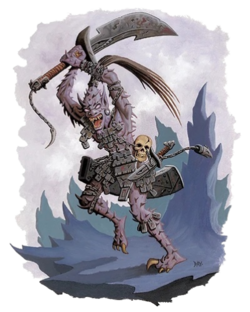
A rarely-encountered people due to their tendancies towards xenophobia and isolation, bladelings are among the only planar natives of the plane of Acheron. Having immigrated to this plane only within the last two centuries, they set up kip in the harshest environs it has to offer, the layer of Ocanthus with its endless storms of razor-sharp shards of black ice.
Bladelings are close in size and profile to the average human, with males and females alike averaging around 6 feet tall. Their skin ranges from light purple to dark black, and keeps a sheen to it at all times; thanks to its nature, it can even be polished, which some more vain bladelings try to keep for greater effect. The sheen also partially comes from their blood; black and oily, although no more flammable than any mortal's blood. As all mammals, they do have hair, its color in the same ranges as skin; a bladeling's hair and spikes are usually of the same color, as the latter is similar in physiological nature to hair. Some even possess facial hair, but its coarser nature causes it to be more similar to spines than that of other species. Eyes tend to be bright purple with the occasional vivid blue or white, with an elven, pure-black sclera; additionally, bladeling eyes tend to be even more reflective than their skin, even seeming to glow under the right lighting much like cat eyes.
Bladeling clothing tends to be well-tailored, specially made for the individual bladeling wearing it and fit to their unique spike pattern. Due to the extra effort needed, their clothing is rarely ostentatious, but this is more out of time concerns than a lack of appreciation for aesthetics. (In fact, something all bladelings seem to enjoy of the outside world is the wider variety of clothing available.) Instead, personal expression tends to be through accessories, with most clouds tending towards a similar, but rarely identical, overall style.
Bladeling Racial Traits
- +2 Strength
- +2 Natural AC
- 10/- Acid Resistance
- Automatic Languages: Common and Bladeling.
- +1 LA
- Alignment Lock: Lawful Evil, Lawful Neutral, Neutral Evil only
Lizardfolk
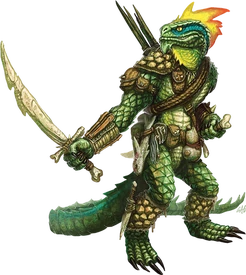
Living mostly in the marshy areas, lizardfolk are large, scaly humanoids who are savage marauders and scavengers. They have no traditions for cultivating food, so they arrange their meals by either hunting prey or raiding the larders of others.
Lizardfolk grow to between 6 and 7 feet tall, and weigh between 200 and 250 pounds. Their scales range in color from dark green to gray to brown. Their thickly muscled tails run from 3 to 4 feet long. Most nonlizardfolk have a very hard time telling the difference between males and females, but the lizardfolk have no such troubles, of course.
Lizardfolk have the same life expectancy and age categories as humans.
Lizardfolk Racial Traits
- +2 Dexterity, +2 Intellect, +2 Wisdom, -2 Constitution
- Automatic Languages: Common and Draconic.
- +1 LA
Giff
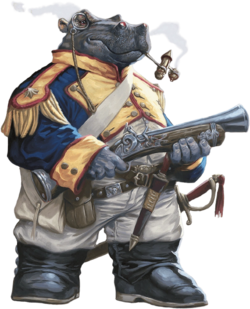
Personality: The giff are not so much a warrior race as a soldiering race. Giff communities organize themselves in a chain of command, freely borrowing grandiose ranks and titles from races they encounter. Giff society is built upon discipline and hierarchy, but they harbor no imperial ambitions. In fact, they care little for land - theirs or anyone else's. Nor do they care for money, preferring payment in what they really value, such as food, weapons, and - especially - explosives. The bigger the explosion, the better they like it.
For all their love of ostentation and arms, giff remain intensely orderly creatures. A giff's word is his bond, with one exception - giff refuse to fight other giff, no matter how well paid either platoon might be.
Physical Description: A giff resembles an anthropomorphic hippopotamus - a gray, broad and seemingly clumsy creature. Shorter than an ogre but much more massive, a giff's bulk disguises quick reflexes and surprising grace. Although herbivorous, giff possess powerful tusks and iron-muscled arms.
Giff would appear terrifying to most races if not for their fashions. Giff demand spit-and-polish military garb, and take this to such an extreme of ostentation as to border on the absurd. No one doubts the bravery or ferocity of the giff and those who know their predilections know to keep a safe distance from them, but few are intimidated by an 8-foot-tall humanoid hippopotamus who hides the entirety of his plate armor beneath a mess of campaign ribbons.
Giff Racial Traits
- +2 Strength, +2 Constitution, -2 Wisdom
- Large Creature
- Automatic Languages: Common and Animal.
- +1 LA
Mortif
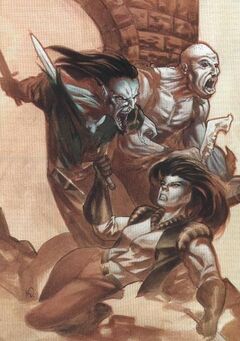
The deathtouched trace their ancestry to a half-undead being - usually a katane or the victim of a bungled resurrection. Although rarely recognized as such, the taint of unlife lingers through generations, and a deathtouched can manifest abilities derived from its unliving ancestor.
Deathtouched tend to be pale and thin, with black, dirty brown, or gray hair. Many have some small physical feature that belies their heritage, such as sharpened canines, a ghoul-like tongue, a faint smell of the grave, eyes that glow red, yellow, or green in low light, or tight, corpselike skin. They wear the clothing and hairstyles of the region they live in but favor fashions that conceal their nature and discourage notice. Deathtouched can be reclusive and are prone to fits of depression that last days or even weeks at a time. They become fond of anyone who can understand or tolerate their affliction.
Most races do not trust creatures that are undead, in whole or in part, and a deathtouched whose ancestry has been exposed is likely to be driven off or killed. Some elves consider them abominations that must be hunted to extinction. This causes most deathtouched to be fearful of others. Neither can deathtouched expect acceptance from their undead kin, who see them as no different from other mortals. Certain cults of death gods treat deathtouched with respect, though, and necromancers might welcome them in exchange for skin, hair, and blood samples, which are invaluable to their experiments. Deathtouched feel a kinship with tieflings but do not get along well with aasimar.
Like the planetouched, the deathtouched have no society or culture of their own and instead blend into existing ones. Mortif, the deathtouched described here, are the most common variety: humans with an undead or half-undead forebear. Other races might also have deathtouched members.
Mortif adventure out of greed, a need for meaning, or a desire for self-validation. Some go out of their way to hunt down their undead progenitor, or all undead, to exact revenge for their torment-filled lives. Others seek to gain mastery over their nature or to gain acceptance by their fellow citizens. Mortif are usually neutral, though there are many chaotic and lawful individuals in their number. Their isolation from society discourages loyalty to any but themselves.
Mortif fight out of self-preservation or greed. They do battle when and if it benefits them and usually protect their own hides before their honor or reputation.
Mortif Racial Traits
- +2 Intellect, +2 Wisdom, +2 Charisma, -2 Consitution
- Automatic Languages: Common.
- +1 LA
Hadozee
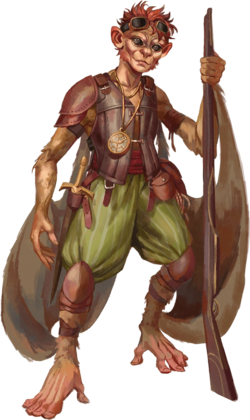
A race of simianlike humanoids, they are covered in light brown fur, with a slightly stooped posture, a shaggy mane, and a fanged muzzle. And they have flaps of skin that hang beneath their arms that enable gliding, if not true flight. Because they're also good climbers and balancers, hadozee are particularly suited for life aboard a ship sailing the seas of adventure.
Hadozee stand at about 5'1/2 to 6 feet tall, though they always seem slightly shorter due to their natural stooped posture. They tend to weigh between 200 and 250 pounds, most of that weight being solid muscle. Their eyes are black and glitter brightly, and their fur can range in color from a light tawny golden brown to a deep chocolate. Hadozee do not really need clothing due to their fur covering, though many who work aboard ships wear harnesses and belts for their tools and weapons. Hadozee generally have about the same lifespan as humans, though they are considered adults a little earlier.
Most fascinating of all, however, is a hadozee's patagial flapsflaps of skin between legs and arms, similar to those of a flying squirrel. With these patagia, the hadozee can launch herself into the air and glide for significant distances. It is not uncommon for hadozee in the rigging of ships not to bother climbing down, but simply throw themselves into the air and glide to another part of the ship.
Hadozee Racial Traits
- +2 Dexterity
- Flight Widget
- Automatic Languages: Common and Animal.
- +1 LA
Tortle
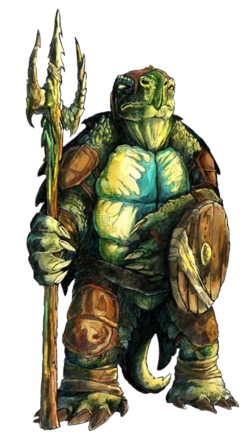
Tortles are humanoid tortoises. Most are peaceful beings, content to ignore the world outside their tribes. Others adapt to the more advanced cultures of the Savage Coast and live as peasants. Each tortle stands approximately 6 feet tall and appears humanlike except for a shell and tail like those of a tortoise.
The natural shell color of a tortle ranges from shiny black to a deep, lustrous purple, and tortle chieftains often encrust their shells with sparkling gems or channel them with gold intaglios. The creature's mouth is beaklike and toothless, and its head, feet, legs, and tail are green, yellow, or black - sometimes one solid color and sometimes pied. Most tortles forego clothing, although warriors often don breastplates and greaves. Tortles speak Tortle and Common. They cannot breathe water, but the Endurance feat aids them in swimming long distances.
Tortles tend to avoid combat whenever possible. When danger threatens, a tortle's first instinct is to plunge into any nearby water and hold its breath until the threat has passed. When forced to fight, tortles form regimented warbales and approach their enemy in groups. Young tortles often form noncombatant bales that carry spare tridents for the warbales.
Most torte tribes along the Savage Coast possess little technology and subsist primarily as hunter-gatherers. They maintain loose contact with other nearby tribes, joining them for hunts, hut building, and other communal activities.
A typical tortle village consists of a cluster of mud and thatch huts just off a beach. Sentry huts, each equipped with a gong or conch shell horn for sounding alarms, form a perimeter 200-300 yards from the central cluster. Notable tortle villages along the Savage Coast are Tlech', R'nach, and Prash. The most unusual tortle settlement is the Free City of Dunwick, which was built around a fallen monastery. Most of Dunwick's citizens are peasant tortles, but representatives from many intelligent races, including goblinoids, dwell there as well. Many of the tortles there embrace the ancient Order of Dunwick and become monks.
Since tortles are adept at working underwater cinnabryl deposits, tribes are often self-sufficient, acquiring their own cinnabryl as well as food, water, and shelter.
Tortles are spiritual creatures. They worship Mother Ocean, the protector: Father Earth, the life-bringer, Brother Shell, the warrior; and Sister Grain, the patron of farmers and fertility. The typical tortle hut contains a seashell shrine dedicated to at least one of these deities. The domains to which these deities can grant access are given on the following table.
Tortle Racial Traits
- -2 Dexterity, +2 Constitution, +2 Wisdom, -2 Charisma
- Armor Skin
- Large Creature
- Automatic Languages: Common and Animal.
- +1 LA
Ghost Elf
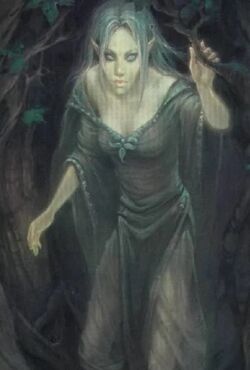
In the depths of the primordial forests, spectral citadels are home to elves unlike any others. Dubbed "ghost elves" for their eerie appearance, this rarely encountered subrace has given rise to a thousand tales of forest demons and lost civilizations. The legacy of the ghost elves is a tale of conflict, betrayal, and vengeance. After a struggle for survival that stretches back to the fall of the drow, the ghost elves now flourish in cities built on the Ethereal Plane. Suspicious and reclusive, they welcome few strangers into their halls.
Ghost elves dwelt on the fringes of elven society. They made their homes amid the ancient roots of the forests, rarely making contact with other races. Over time the ghost elves grew more and more isolated, eventually becoming little more than a legend.
Thousands of years ago, during the elven civil war that led to the fall of the drow, the ghost elves maintained their isolation and remained neutral in the great racial struggle. After the defeated drow retreated into the Underdark, they schemed against their distant cousins and soon launched an assault on the ghost elves. The very shelter that had kept the ghost elves safe became fiercely contested battlegrounds. The peaceful ghost elves were no match for the seasoned dark elven troops and were easy fodder for the sacrificial altars of Lolth. They were virtually wiped out in the blink of an eye. The other surface elves were either unwilling or unable to aid their beleaguered kin, something the ghost elves have never forgotten or forgiven.
Help eventually arrived - from an unexpected source. As the defenses of the last settlement were collapsing, an alien entity calling itself Thule appeared and offered to save the ghost elves in return for their service. Appalled at the slaughter of their people, the ghost elven leaders agreed without a second thought, signing the contract that Thule proffered.
They were foully tricked. Thule revealed himself as the Archduke Thulikazt, a pit fiend of almost godlike power, and took the ghost elves to his home in the Nine Hells of Baator. There he enslaved them, slowly destroying their spirits and their strong connection to the land. The ghost elves called upon their deities to save them, but to no avail - Thulikazt's bargain was binding. For hundreds of years, they toiled for the archfiend, and thousands were slaughtered in savage arena battles and pointless experiments for Thulikazt's pleasure. Ghost elven historians call this time "the Tempering."
Countless centuries passed and Thulikazt grew lax, allowing his slaves (whom he believed completely broken) to take up arms and join his forces in the Blood War. The ghost elves learned the arts of war and conquest from fiendish generals and hellish sorcerers. They became Thulikazt's elite bodyguard, drawing admiration and envy from other fiends. This would prove the archduke's ultimate undoing.
The ghost elves secretly contacted their master's enemies and offered to serve those lesser fiends in return for aid in destroying their hated master. Greedy for the service of Thulikazt's elite troops, the baatezu lords formed an alliance to lay siege to his citadel. The ghost elves used the battle as a distraction, killing Thulikazt and opening a gate to the Material Plane in the confusion. When the fortress finally fell, the fiendish generals found only Thulikazt's mutilated corpse and a note of thanks. The ghost elves had won their freedom.
Fearing fiendish retribution, the ghost elves searched for somewhere to hide. It was then that they noticed a startling change in themselves: By severing their connection to the earth, Thulikazt had accidentally gifted the ghost elves with a strange connection to the Ethereal Plane, granting the most powerful ghost elves the ability to slip between the material world and the Ethereal Plane. Upon coming to grips with their newfound powers, the ghost elves set about creating a portal to the Ethereal Plane, and one stone at a time, they transferred materials to the Ethereal Plane to build their new homes.
Today ghost elves live on the Ethereal Plane. Their cities are usually built deep in woodlands and all are at least partially underground. Due to their long captivity and the dangers their settlements attract, their society has a strong martial bent. A thousand years have not cooled the anger of the devils humiliated by "elven treachery," and even today they seek out and destroy ghost elves whenever they can. For their part, the ghost elves launch preemptive strikes against their enemies whenever possible, relying on their hidden cities for defense.
Personality: The ghost elves have been strongly affected by their history. Before the Tempering, they were a carefree people with a passion for life. Much of that has evaporated, replaced by a harsher outlook. The typical ghost elf now seems a stern creature with little passion. In truth, ghost elves are gentle and nurturing at heart, forced to extreme measures to survive. They are wary; earning their trust involves many subtle tests and trials. Never intentionally haughty, a trait they despise in their cousins, they maintain a distance that makes them seem cold.
Ghost elves are still passionate about their homes and people, and they defend these to the last, exacting terrible vengeance against those who wrong them. A serious, calculating mindset allows them to hold their own against their many enemies. Dwarves compare ghost elves to mithral: beautiful and delicate in appearance, but stronger than the hardest steel.
Physical Description: Ghost elves have the same range of height and weight as elves but are slightly frailer, a consequence of the destruction of their bond with the land. They reach adulthood at about age thirty and have a life span roughly a hundred years shorter than that of other elves, although they do not show their age until a few years before death.
Gray hair and pale skin are nearly universal, with the occasional throwback having jet-black hair. The eyes of ghost elves are their most striking feature; they are like twin mirrors lacking white, iris, and pupil. Their skin glows with a pale white light in the darkness. They are often mistaken for ghosts even by other elves, hence their name.
Ghost elven attire is usually light and flowing, colored gray, silver, or white. In battle, they favor light armor such as leather or mithral shirts. On the Material Plane they dress like ordinary elves in an effort to disguise themselves from distant observers.
Ghost Elf Racial Traits
- +2 Dexterity, +2 Intelligence, -2 Constitution
- Automatic Languages: Common and Elven.
- +1 LA
Grippli
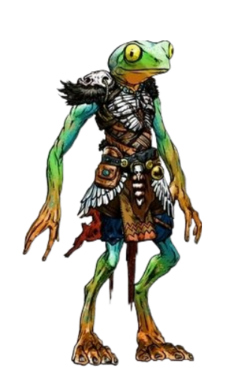
Grippli resemble small, intelligent, humanoid tree frogs. Primitive and largely peaceful, grippli lead a simple existence. Living off the bounty of the swamps and rainforests they inhabit, they spend their days hunting insects and gathering fruit. Warlike races that neighbor grippli settlements soon learn to avoid them as, although they rarely attack anything but insects, the grippli prove effective and mobile defenders of their homes and keep few possessions worth the risk of pillaging.
Grippli live in isolated family groups, clustered into loose villages led by an elder priestess known as the tribe mother. These families tend to be small, as the long-lived grippli produce few offspring. Grippli devoutly follow the decisions of the tribe mother. In theory. this elder priestess holds divinely granted power over her village. In practice, she rarely exerts that power, leaving the day-to-day leadership of the tribe to its most experienced hunters, often elder males. Grippli tribes require little governance in any case, each family making most of its own decisions, barring religious matters and a village-wide crisis or dispute.
Few grippli apply themselves as craftsmen or artisans. Simple wood, stone, and vine creations make up the majority of the weapons grippli use in hunting and defense, while they pass rare metal weapons and tools down through the generations as treasured heirlooms. Grippli rarely fashion even the simplest trade goods and more rarely do their spellcasters craft complex magic items, although potions, alchemical creations, and herbal tinctures are quite common.
Unscrupulous traders sometimes take advantage of the grippli, selling them worthless baubles in return for rare and valuable herbs, unguents, and extracts from the deep jungle. The grippli don't see themselves as getting taken advantage of, though. They understand the value outsiders place on their purchases, but they in turn prize brightly colored curios. Polished quartz, vibrantly dyed cloths, colored glass, and eclectic collections of foreign signs brighten the majority of grippli homes.
Besides the rare trader, the grippli deal only with the insects they hunt and the giant snakes and spiders that hunt them. Such giants seem to favor the taste of grippli flesh and frequently attack grippli communities. Lizardfolk and kuo-toa also sometimes hunt grippli, although both races have strict taboos against eating the smaller humanoids' flesh. The enmity between these races seems to date to their distant pasts, perhaps even to some conflict between their gods.
The origins and history of the grippli are shrouded in mystery, even to themselves. As grippli do not keep records, except for those relevant to their worship, their past remains a subject of conjecture and guesswork. The prevailing theory holds that grippli exist now much as always, a humble race of peaceful recluses content with what the land provides and the world they know. This surprising peacefulness seems to stem from their simple faith in their nameless froglike goddess. With the land providing them all they need and a faith to further content their modest lives, the grippli have had little need to change over the centuries.
Personality: In the presence of strangers, grippli become noticeably skittish. They usually climb the nearest tree and hide upon spotting other humanoids or any other creature deemed dangerous. Among their own kind or those they accept as friends, grippli show their true character. Light-hearted and cheerful, they value familial bonds and the simple pleasures of food, games, rest, and shiny objects from the outside world. Other humanoids sometimes perceive relaxed grippli as blase, even lazy, but a relaxed grippli might snap to full alertness at a moment's notice.
Although reluctant warriors, grippli are far from cowardly or inept in combat. When forced to fight, they do so cunningly and viciously, leaving surviving assailants with no doubt about the danger of attacking again. Thus, tales of grippli fighting ability keeps them safe from most of their enemies, as the latter consider an assault upon the grippli's secluded homes not worth the risk, assuming they can find the grippli in the first place.
Physical Description: A typical grippli stands 2 to 2-1/2 feet tall and weighs approximately 30 lbs, although the very old and particularly powerful hunters might stand and weigh twice that. A gripplis head and body appear similar to those of a giant frog, but its hands and feet look humanlike. Grippli skin color varies dramatically depending on their environment, ranging from the brown-splotched green of swamp grippli to vibrant blues, yellows, and reds of rainforest-dwelling tribes. Grippli rarely wear clothing, although they often decorate themselves with jewelry and trinkets that members of most other races consider gaudy.
Grippli reach adulthood at 30 years and live to around 180 years old, while females live slightly longer on average than males. A female grippli gives birth at most six times in her life, becoming fertile at roughly 25-year-intervals after she reaches maturity.
Grippli Racial Traits
- +2 Dexterity, -2 Strength
- Small Size
- Automatic Languages: Common and Animal.
Slyth
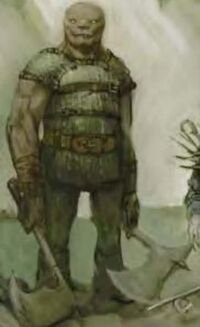
In her humanoid form, a slyth appears as a bald human, slightly taller than average, with softer and more rounded features. Her skin tones can vary in color, but brown hues are the most common. The slyth's real form is that of an amorphous, oozelike creature whose body is midway between a solid and a liquid. In this shape, she resembles a puddle of syrup, mud, or oil.
Thought by some to be genasi descended from human pairings with earth and water elementals, another theory traces their origin to aboleth experimentation with humans and gelatinous cubes. An uncommon species, they are only found underground in vast cavern networks such as Faerun's Underdark.
Slyth Racial Traits
- -2 Strength, +2 Dexterity, +2 Wisdom
- +1 LA
- Automatic Languages: Common.
Goliath
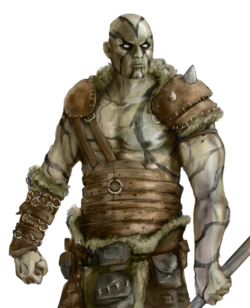
Goliaths are massive creatures unafraid of throwing their weight around in a fight. Highly competitive, these strong nomads can prove to be powerful allies and welcome additions to any adventuring party. A typical goliath is larger than the largest half-orc. Most stand between 7 and 8 feet tall and weigh between 280 and 340 pounds. Unlike with most other races, there is no appreciable difference in height or weight between male and female goliaths.
Goliaths have gray skin, mottled with dark and light patches that goliath shamans say hint at a particular goliath's fate. Lithoderms - coin-sized bone-and-skin growths as hard as pebbles - speckle their arms, shoulders, and torso. Their skulls have a jutting eyebrow ridge, wide jaw, and occasional lithoderms as well. Female goliaths have dark hair on their heads, grown to great length and always kept braided. Male goliaths generally have hair only on their limbs. Goliaths' eyes are a brilliant blue or green, and they often seem to glow a little from underneath their furrowed brows.
Because their skin mottling has cultural significance, goliaths generally dress as lightly as possible, displaying their skin patterns for all to see. For the same reason, few goliaths would willingly get a tattoo - to draw on one's skin is tantamount to trying to rewrite one's fate. Goliaths instead decorate themselves with jewelry, often sporting ear, nose, or brow rings. A goliath's lithoderms are also common places to embed a gem or two, since they have few nerve endings and stand out on the goliath's body already.
Goliath Racial Traits
- +2 Strength, -2 Dexterity, +2 Constitution, +2 Charisma: Goliaths are massively muscled, but their bulk sometimes gets in the way when they're trying to be nimble.
- Medium: As Medium creatures, goliaths have no special bonuses or penalties due to their size.
- +2 bonus on Sense Motive checks: When speaking to one another, goliaths tend to augment their verbal communication with subtle body language. They are likewise able to "read" the unintentional body language of others.
- Automatic Languages: Common and Giant.
- Favored Class: Barbarian. A multiclass goliath's barbarian class does not count when determining whether he takes an experience point penalty. The tribal life of the goliaths produces many barbarians.
Level Adjustment: +1.
Half-Ogre
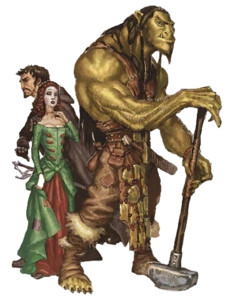
Half-ogres are usually born out of violence and slavery. They are considered weak and soft by ogre standards, and bestial and ugly by human standards. Driven by the social needs of both races, half-ogres try hard to win acceptance to avoid becoming lonely and despondent. Half-ogres stand between 6 1/2 and 7 1/2 feet tall, with thick bones, large hands and feet, and dense muscles. Half-ogres raised by ogres are often unkempt and unwashed, their hair long and rarely combed. (Males sport shaggy beards, as well.) Those raised in the human world dress and wash as they are taught. Some wear large hooded cloaks to hide their appearance.
Half-Ogre Racial Traits
- +2 Strength, +2 Constitution, -2 Charisma. Half-ogres inherit the strength and endurance of their ogre parent, but are disadvantaged in social circles.
- Medium: As Medium creatures, half-ogres have no special bonuses or penalties due to their size.
- Natural Armor: Half-ogres have tough hides, which provides them a +1 natural armor bonus to AC.
- Low-Light Vision: Half-ogres can see twice as far as a human in starlight, moonlight, torchlight, and similar conditions of poor illumination. They retain the ability to distinguish color and detail under these conditions.
- Automatic Languages: Common and Ogre.
- Favored Class: Fighter. A multiclass half-ogre's fighter class does not count when determining whether he suffers an XP penalty for multiclassing.
- Level Adjustment: +1. Half-ogres are slightly more powerful and gain levels more slowly than most other races
Sharakim
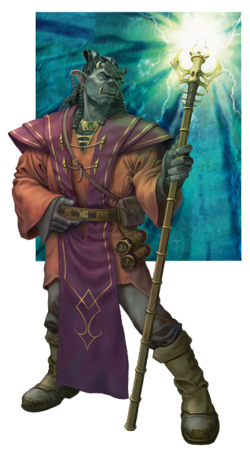
Sharakim live in small villages and towns. They are comfortable in hills and mountains, especially places that feature long shadows and high cliffs on every side. They are eager for outside contact, and thus settle close to other races. They make frequent forays to nearby towns and encourage their neighbors to visit them, whereupon they take the part of lavish hosts. Sharakim spend their waking hours fighting the impression people assume based on their appearance; only in the privacy of their own homes do they relax and gather their thoughts.
Sharakim stand between 5 feet and 6 feet tall and weigh 140 to 275 pounds. Their skin ranges from light gray to coal black; their hair is thick but not coarse, and such a deep black it seems almost blue, though some sharakim sport silver or white streaks. They usually have either jet-black or slate-gray eyes, and more rarely eyes of dark blue or dark green. Small, curved horns protrude from both temples, and their lower canines are sharp tusks that jut up past their upper lips. Sharakim noses are usually short and snubbed, with wide nostrils.
Sharakim dress as well as their circumstances allow, to distinguish themselves from orcs. They prefer finely made shirts and pants, with soft leather boots and gloves. Many wear hats with broad brims, pulled low to cover their horns, while others prefer cloaks with deep hoods. Sharakim keep their thick fingernails trimmed, and their tusks and horns polished. They decorate their horns and tusks, carving them like ivory, capping them with precious metals, or even imbedding gems in them. Their hair is braided or pulled back and held by a fine metal clip. Sharakim hate to expose their feet and hands, because both are oversized and feature thick, talonlike nails.
Sharakim Racial Traits
- +2 Strength, -2 Dexterity, +2 Intelligence
- Darkvision: Sharakim can see in the dark out to 60 feet. Darkvision is black and white only, but it is otherwise like normal sight, and sharakim can function just fine with no light at all.
- +1 natural armor bonus: Sharakim skin is tough and difficult to pierce.
- Shadow Affinity (Ex): Sharakim are born to darkness, and despite their claims they operate best in night and shadow. In areas of darkness or shadowy illumination, a sharakim gains a +2 racial bonus on Hide, Move Silently, Search, and Spot checks.
- Light Sensitivity (Ex): Sharakim take a -1 penalty to attack rolls in bright sunlight or within the radius of a daylight spell.
- +1 racial bonus on attack rolls against orcs (including half-orcs): Sharakim despise orcs, and learn special combat techniques that enable them to fight them more effectively.
- Automatic Language: Common and Orc.
- Favored Class: Wizard. A multiclass sharakim's wizard class does not count when determining whether he takes an experience point penalty for multiclassing.
- Level adjustment +1.
Aarakocra
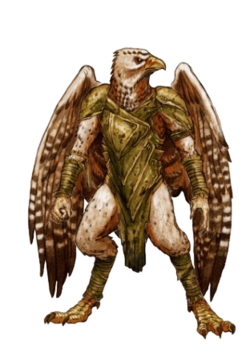
The aarakocras are a race of intelligent birdlike people who live in mountainous areas. Aarakocras love to soar high in the sky for hours on end, riding the thermal currents and updrafts with their wings spread wide. From a distance, it's easy to mistake them for eagles or some other large bird of prey.
Aarakocras stand about 5 feet tall and have a wingspan of 20 feet. On average, they only weigh about 90 pounds. Midway along each wing they have a three-fingered hand, which is only useful when the wings are folded in. Their wing muscles attach to a bony chestplate, and their powerful legs end in sharp talons that can be drawn back, allowing aarakocras to use their feet as hands. Their heads combine the features of an eagle and a parrot. Their beaks are gray-black, and their eyes are black as well. The males are brightly colored, usually red, orange, or yellow, while the females are either brown or gray.
Aarakocra hatchlings aren't permitted to leave the nest for the first three months of life. After that, they are considered children for only about five years. At this point, they are kicked out of the family's portion of the tribe's communal nest and given a place of their own. Aarakocra can live to be over 100 years old.
Aarakocra look down on other races, both literally and figuratively. They pity the poor landbound fools for their lack of mobility, and they often criticize them for a "lack of perspective."
Aarakocra Racial Traits
- -2 Strength, +2 Dexterity, +2 Intellect. Lightweight but fast, the aarakocras are built for speed over bulk.
- Medium-size: As Medium-size creatures, aarakocras have no special bonuses or penalties due to their size.
- +1 natural armor.
- Automatic Languages: Common, Auran, and home region. Bonus Languages: Draconic, Elven, Orc, Sylvan. When aarakocras speak, they punctuate their words with birdlike sounds, much in the way of a parrot imitating human speech.
- Favored Class: Fighter.
- Automatic Languages: Common and Animal.
- Level Adjustment: +1
Bullywug
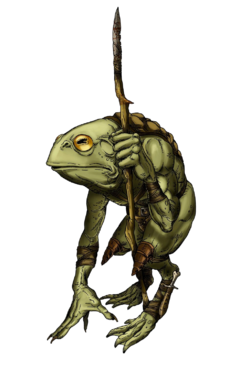
Bullywugs were frog-like, amphibious humanoid creatures that could be found among the swamps and marshes.
Bullywugs were amphibian humanoids with the head of frogs, about the size of humans, with leathery, green or gray-mottled skin, and webbed digits. Their tongues were so large they almost prevented them from being capable of speaking common.
Bullywug Racial Traits
- +2 Dexterity and +2 Constitution
- Frog Hop - The ability of a Bullywug to leap great distances using its strong legs. (Essentially this would be a flight widget causing the animation of jumping up and down.)
- The ability to communicate with frogs and toads.
- Automatic Languages: Common and Animal.
- LA: +1
Krynnish Minotaur
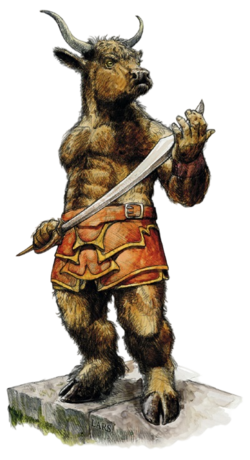
At home both on land and at sea, minotaurs live in an honor-based society where strength determines power in both the gladiatorial arenas and in daily life.
Minotaurs believe in the superiority of their race above all others. They believe their destiny is to rule the world. From youth, minotaurs are trained in combat and warfare and instilled with a strict code of honor. The militaristic society of minotaurs gives them a rigid view of the world, clearly delineated in black and white. Minotaurs value strength, cunning, and intelligence. The ultimate test of all three virtues is conducted in the Great Circus, an annual contest held in a gladiatorial arena.
Minotaurs are physically imposing, standing between 6 1/2 and 7 1/2 feet in height and weighing between 300 to 450 pounds. A minotaur's upper body is humanoid, with broad shoulders, a deep chest, and strong arms ending in fully articulate hands. For the most part, the legs are also humanlike, although their feet end in cleft hooves. Their powerful bodies are covered with short, thick fur, ranging in hue from red to brown, with rare occurrences of black, tan, or white-furred individuals. Minotaur heads are clearly bovine in nature. They have large, deep-set eyes in shades of dark brown and black. Minotaurs have short, yellow-white horns that grow from their temples, 6 to 12 inches long for females, and anywhere from 1 to 2 feet long for males. Minotaur manes are a shade or two darker than their fur.
To nonminotaurs, the physical differences between males and females may not be immediately apparent, since both sexes are equally powerfully built and there is no role distinction between the sexes. Minotaur dress tends to be austere and simple, nothing more than a harness and a leather skirt, although those of noble rank may wear loose-fitting robes. The harness carries weapons as well as providing a place for the minotaur to hang trophies. Minotaurs are considered adults around the age of 17, and can live to be over 150 years old.
Krynnish Minotaur Racial Traits
- +2 Strength
- Natural armor: Minotaurs have exceptionally tough hides, which gives them a +2 natural armor bonus to AC.
- +2 racial bonus on Intimidate, Swim, and Use Rope checks. Minotaurs are a people familiar with the sea, and are naturally adept at skills useful among seafarers.
- Automatic Languages: Common and Minotaur.
- Favored Class: Fighter. A multiclass minotaur's fighter class does not count when determining whether he suffers an XP penalty for multiclassing.
- LA: +1
Golmoid
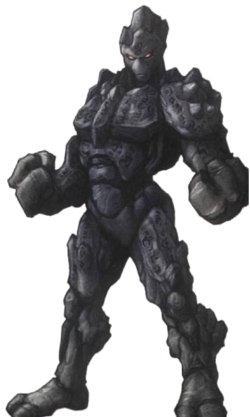
Originally crafted by gnomes to work as teamsters, haulers, and heavy lifters, golmoids labored for millennia as mindless constructs. Over the years, families that owned golmoids began to ascribe living qualities to their construct laborers, giving them gnome names and ascribing gnome traits to their actions.
A thousand years ago, at the behest of his daughters, a gnome wizard granted his family's golmoid a rudimentary form of intelligence. Soon thereafter, gnome wizards began competing with one another in escalating attempts to grant their golmoids a greater level of intelligence than that of their neighbor's. Eventually, all golmolds received sentience, and began to interact with one another as all thinking beings do.
The original sentient golmoid, who had his intelligence augmented several times by his family's wizards, asked for and received his freedom. He quickly spread the word to other golmoids of his liberation, and within a week the gnomes found themselves with a terrible dilemma: to retain a sentient race as slaves or to let their precious construct laborers have their desired freedom. To their credit, it took only a day for the gnomes to decide to release the golmoids.
As a gift to the creations of his children, Garl Glittergold breathed true life into the clay, stone, and bronze bodies of golmoids, making them humanoids. In thanks for their newfound gifts, the golmoids formed a binding treaty of mutual aid with the gnomes. In the millennium since, the golmoids have struggled through hard times and celebrated periods of plenty, and although they solemnly remember their vow of aid to the gnomes, golmoids work as no being's slaves.
Golmoids tend to be quiet, which makes nongnomes think of them as dour or aloof. In truth, the unexpressiveness of their bodies simply masks the joy of life burning within them. They seldom seem at ease among any race other than gnomes and therefore come across as cold and hard to read to those new to them. Yet like all beings, what stirs beneath their skins distinguishes their individual personalities. The golmoids are as dynamic in their personal inclinations as members of their patron race, and while they cannot smile, their laughter is thunderous.
Most golmoids prefer and enjoy a simple agrarian life. They need little and ask for less. A history of servitude reminds the golmoids that they neither wish to work for others nor have others work for them. As such, every golmoid strives for self-sufficiency, but whether he gains it or not is another question. Golmoids prefer to deal with others in a frank, forthright manner, leaving little room for complex negotiations. Their merchants are notoriously inflexible, demanding to be paid based on the merits of their work without haggling.
When in the company of gnomes, however, the playfulness of their patron race rises to the surface, and it is then that a golmoid might show the passionate love of life they all possess.
Physical Appearance: Adult males appear to be plain-featured, muscular men towering more than 7 feet tall, with oversized shoulders and hands sheathed in stonelike skin. Their faces are plain and smooth-featured, accented by burning red eyes the color of hot magma. Skin color ranges from sandy tan to black.
Females are the same height as males, but are slightly less uniform in overall appearance. They also have smooth-featured faces like mannequins, and the trademark burning red eyes. Females rend to be thinner-limbed and bear a more natural appearance. Their skin color ranges from light tan to ruddy brown.
All golmoids have spatulate feet with only one separation for a large toe. Golmoids fingers are thick and rocky, the last three fingers melding into one wide digit.
Because of the similarities in appearance between golmoids, golmoid sculptors delicately carve the skin of their fellow golmoids to reflect deeds accomplished, much like tattooing among soft-skinned races. Golmoid warriors often have their skin carved into the form of armor. For these reasons, golmoids hold an almost religious reverence for their skin carvers.
Golmoid Racial Traits
- +2 Strength, +2 Constitution, -2 Dexterity
- Natural Armor: Their stone-like skin grants golmoids a +2 natural armor bonus.
- +2 racial bonus to all Craft checks. Golmoids are gifted craftsmen, and some speculate that their created forms give them an instinctive knowledge of manufacturing.
- +4 racial saving throw bonus against enchantment spells and effects. Golmoids have some residual resistances of constructs.
- Bonus Feat: Golmoids gain Endurance as a bonus feat at 1st level.
- Automatic Language: Common and Gnome. Golmoids learn the language of their patron race as well as those they see as allies to gnomes.
- Favored Class: Fighter. A multiclass golmoid's fighter class does not count when determining whether he takes an experience point penalty for multiclassing. Golmoids are powerful and competent combatants when roused to anger.
- Level Adjustment: +1
Half-Giant
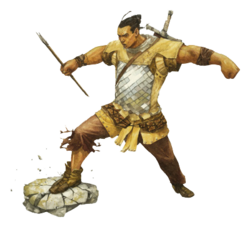
Half-giants are a cross between humans and giants, bred into existence in a desert land by cruel sorcerer-kings intending to use them as warriors and laborers. Every half-giant who was born and survived early childhood could look forward to nothing but a life of suffering, as with any people kept in bondage. Some half-giants found that their forced breeding had engendered within them a spark of psionic power. With the aid of this secret power, many half-giants escaped their circumstances to seek a new home deep in the desert, where they are free to discover their own destiny.
Personality: Half-giants, for the most part, retain human sensibilities. They are curious, interested in cooperation and communication, and have a general tendency toward kindness. (Of course, there are exceptions.) They are quick to pick up the morals, customs, and habits of the areas in which they settle down.
Physical Description: Half-giants typically stand from 7 feet to nearly 8 feet tall, and weigh from 250 to 400 pounds, with men noticeably taller and heavier than women. Most half-giants have tightly braided black hair and deep coppery complexions. Half-giants often prefer grandiose dress when they can afford it, sporting fanciful or intimidating clothing.
Relations: Most other humanoids are put off by half-giants due to their abnormally large size. In fact, many are first taken for young (if strangely well-groomed) hill giants. Upon getting past their initial trepidation, however, most other humanoids find half-giants of good alignment to be outgoing, kind creatures.
Alignment: Most half-giants are good-aligned, but all alignments can be found within their ranks.
Half-Giant Lands: Half-giants recently settled in the deepest part of the hot deserts to the south. Of the land they came from, half-giants speak little, other than to say that where they live is similar to where they once toiled.
Religion: Half-giants, as a rule, have a particular disdain for religion, sometimes going out of their way to speak badly of a deity. It's not that they don't believe in deities, but that they don't believe that a deity always has the best interests of its worshipers at heart. Individual half-giants have enough courtesy and sensibility to keep their observations to themselves when in the company of a good companion with pious inclinations. A few half-giants even take up the cloth themselves.
Language: Half-giants speak Common. Those with higher than average intelligence often learn Giant.
Names: Half-giants have a childhood name and a given name, the latter usually bestowed by friends or by the community in which the half-giant originally grew up. Most half-giant names reflect some aspect of the desert land that the half-giants inhabit, though a few strange place names are also thrown in (apparently remembered from their former homes of long ago).
Male Given Names: Sandking, Dunewalker, Sunharrower, Drywell, Stormrider, Desertstrider, Saltwalker, Raam.
Female Given Names: Oasis, Sandrose, Breath, Goldfl ower, Sweetwater, Raincaller, Nibenay.
Adventurers: Half-giants have already traveled far to found their desert settlements. For some, wanderlust is a way of life, and seeking after glory, fortune, or even a life of high adventure is something any half-giant can understand and accept - though most of them are content to stay in their settlements and listen to the tales of faraway lands from those who have adventured there.
Half-Giant Racial Traits
- +2 Constitution, +2 Strength, -2 Dexterity.
- Medium size.
- Low-light vision.
- Fire Acclimated: Half-giants have a +2 racial bonus on saving throws against all fire spells and effects.
- Automatic Language: Common and Giant.
- Favored Class: Barbarian.
- Level adjustment: +1.